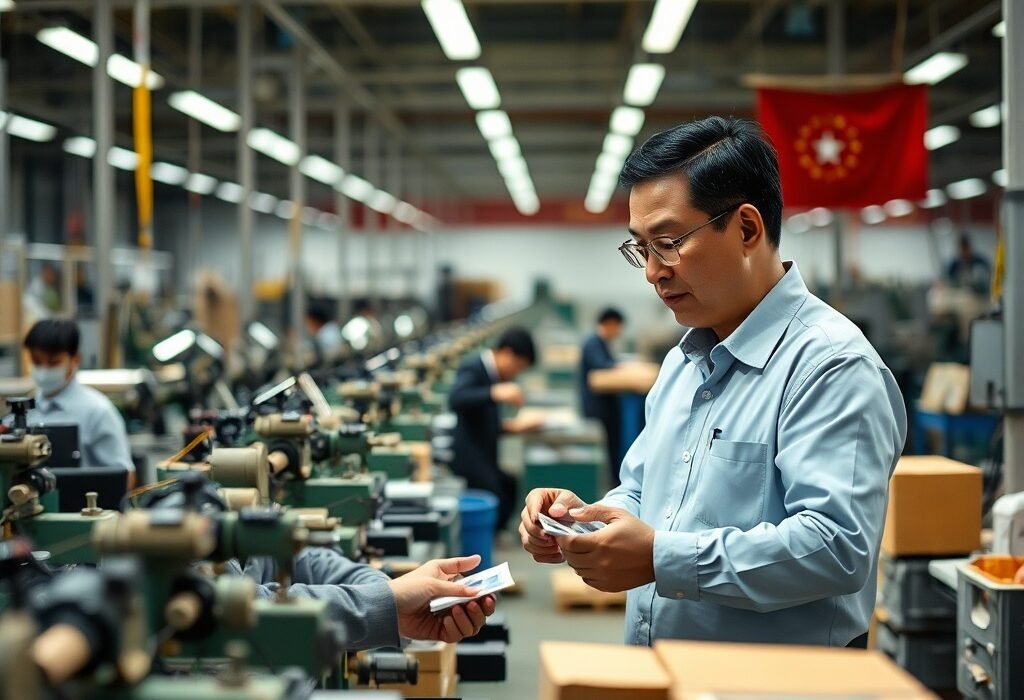⏱️ Reading time: 7 min
The answer to how to buy directly from Chinese factories gives you access to unbeatable prices, product customization, and reliable supply chains — but it’s also a process that requires strategy and awareness. Whether you’re an importer, retailer, or brand owner, this guide will show you how to source from China the right way — safely, efficiently, and profitably.
Why Buying Directly from Chinese Factories Makes Sense
When you skip trading companies and middlemen, you get factory-direct prices, faster feedback, and full control over your product quality and branding.
China’s manufacturing ecosystem covers every category imaginable — from electronics and apparel to machinery, automotive parts, and power systems. By connecting directly with verified manufacturers, you ensure long-term reliability and save costs on every order.
🖼️ Image Idea: A photo of a Chinese factory floor or workers assembling products.
Step 1 – Find Verified and Reliable Manufacturers
Not every supplier online is a real manufacturer. Many are middle agents.
Use platforms like ChinaWholesaleHub.com, where each listed factory is verified for registration, capability, and export compliance.
Look for:
- Factory address (not office address)
- Certifications like ISO, CE, or RoHS
- Clear product range specialization
- Export experience and response rate
🧩 Also read: How to Verify a Chinese Factory Before Placing Orders
Step 2 – Communicate Clearly with the Factory
Once you’ve found a factory, open communication with a clear, professional message.
Keep it short but specific:
- Product requirements (size, specs, packaging)
- Target quantity and delivery timeline
- Customization or branding needs (OEM/ODM)
- Payment terms
💡 Tip: Use written chat or email and confirm every change in writing — this avoids miscommunication later.
🖼️ Image idea: Buyer emailing or video calling a factory sales manager.
Step 3 – Request Samples and Factory Documentation
Before any bulk order, request a sample. It’s your best quality assurance step.
Also, ask for:
- Factory business license
- Export license
- Product test reports
- References of previous export clients
A trustworthy manufacturer will readily provide these documents.
🧩 Also read: OEM and ODM Manufacturing in China – Buyer’s Guide
Step 4 – Negotiate the Right Factory Price
Negotiation with Chinese factories is an art of balance. Focus on long-term cooperation, not short-term cost-cutting.
Discuss:
- Price breakdown by components
- Payment structure (e.g., 30% deposit, 70% before shipment)
- Lead time and packaging options
- After-sales or warranty conditions
Factories value respectful negotiation and loyalty — it often leads to better pricing over time.
🖼️ Image idea: Two business professionals shaking hands, representing deal closure.
Step 5 – Secure Safe Payment & Shipping Terms
Never pay 100% upfront. Standard safe structures include:
- 30/70 rule (Deposit + balance after inspection)
- Escrow or Trade Assurance for first-time orders
- Letter of Credit for large transactions
Use only official factory accounts, never personal ones.
For shipping, confirm FOB/CIF terms, logistics partner, and customs requirements early.
🧩 Also read: Safe Payment Methods When Buying from Chinese Manufacturers
Step 6 – Build Long-Term Partnerships
Once trust is built, the goal should be long-term collaboration.
Reliable factories often offer:
- Better prices for consistent clients
- Priority production scheduling
- Product upgrades and R&D support
Stay professional, pay on time, and maintain communication even when not ordering — it builds loyalty that benefits both sides.
🖼️ Image idea: A long-term partnership visual — handshake over shipping containers or factory background.
Common Mistakes to Avoid
- Choosing suppliers based only on lowest price
- Skipping document verification
- Paying via non-official accounts
- Ignoring cultural communication styles
- Not requesting samples before ordering
Conclusion
Buying directly from Chinese factories is one of the smartest moves for any serious global buyer — but only if done systematically.
By following the steps above and using ChinaWholesaleHub.com to connect with verified factories, you’ll secure better deals, higher quality, and lasting partnerships.
More Articles of Interest
- 🔗 How to Verify a Chinese Factory Before Placing Orders
- 🔗 OEM and ODM Manufacturing in China – Buyer’s Guide
- 🔗 Safe Payment Methods When Buying from Chinese Manufacturers
FAQs — How to Buy Directly from Chinese Factories
1. What does “buy directly from Chinese factories” mean?
Buying directly from factories means sourcing from manufacturers who produce the goods themselves (not trading companies or middlemen). This gives you better pricing, customization (OEM/ODM), and production control — but it requires verification, clear communication, and some process discipline.
2. How can I find verified Chinese factories?
Start with platforms that vet factories (like ChinaWholesaleHub). Verify business licenses, export records, certifications (ISO/CE/RoHS), ask for factory photos/videos, request references, and — if possible — use third-party audits or live video inspections. See our verification checklist in How to Verify a Chinese Factory.
(Internal link → /blog/verify-chinese-factory)
3. Do I need a business license to order from a factory?
Not always. Many factories accept sample orders from individuals or small businesses. For bulk imports, customs clearance, and better payment terms it’s recommended to use a business entity and provide official import documentation.
4. What is MOQ and can I negotiate it?
MOQ = Minimum Order Quantity. It varies by product and factory. Smaller MOQs may be available at higher per-unit prices or by combining orders, using existing molds, or paying for partial tooling costs. Always negotiate MOQ when you discuss pricing.
5. How long does sourcing and production typically take?
Expect 1–3 weeks for supplier shortlisting and samples (depending on shipping), and 15–45 days for mass production for most OEM orders. Complex products or custom tooling may extend timelines.
6. How should I request samples? What should I check?
Ask for a physical sample (paid or free depending on factory policy). Check dimensions, materials, finishes, functionality, labeling, packaging, and any test reports. Use the sample to finalize specs and a pre-production approval.
7. Which payment methods are safest for factory transactions?
Common safe methods: T/T with staged payments (e.g., 30% deposit, 70% after inspection), escrow/trade-assurance services for first-time orders, or Letter of Credit (L/C) for large contracts. Avoid paying 100% upfront and always verify the factory’s bank details.
(Internal link → /blog/safe-payment-methods-china-factories)
8. How can I protect my product design and IP?
Use NDAs before sharing full designs, register trademarks in target markets, include IP/ownership clauses in contracts, and work with trusted, verified OEM partners. For high-risk products, avoid sharing complete production-ready files until a legal framework is in place.
9. Can factories dropship directly to my customers?
Some factories offer dropshipping or direct fulfillment. Confirm packaging, labeling, customs documentation, and order tracking capability before relying on this model. Dropshipping works best with consistent SKUs and small order volumes.
10. What incoterms should I understand (basic overview)?
Common terms: FOB (Factory loads cargo on board — buyer arranges freight from port), CIF (Cost + Insurance + Freight to buyer’s port), DDP (Delivered Duty Paid — seller handles import duties). Clarify incoterms early to avoid cost surprises.
11. What import documents are typically required?
Typical documents include Commercial Invoice, Packing List, Bill of Lading/Airway Bill, Certificate of Origin, and any product-specific certificates (CE, FDA, SGS reports) required by your country.
12. What if the product arrives defective or not as specified?
Mitigate risk with pre-shipment inspections (AQL), detailed specs/contracts, photos of production, and staged payments. If defects occur, use inspection reports to negotiate rework, replacement, or partial refunds. Escrow or trade-assurance services can protect buyers on first transactions.
13. How can I visit a factory and what should I look for?
Arrange visits through the factory contact or your sourcing agent. Check production lines, worker skills, equipment, inventory handling, QC processes, health & safety, and export packing. If an in-person visit isn’t possible, request live video walkthroughs or a third-party audit.
14. I don’t speak Chinese — how do I handle communication?
Many factory sales teams speak basic English. Use clear written emails, translation tools, or hire a local sourcing agent/translator. WeChat and WhatsApp are commonly used for fast communication; maintain written confirmations for all agreements.
About ChinaWholesaleHub
ChinaWholesaleHub is a factory-focused global sourcing platform that connects international buyers directly with verified Chinese manufacturers for OEM/ODM production and factory-direct pricing. We vet export-ready factories, simplify communications, and provide end-to-end sourcing support — from supplier checks and sample coordination to quality control and logistics — so brands, retailers, and importers can scale with confidence and lower costs while retaining full control over product design and supply chain.


